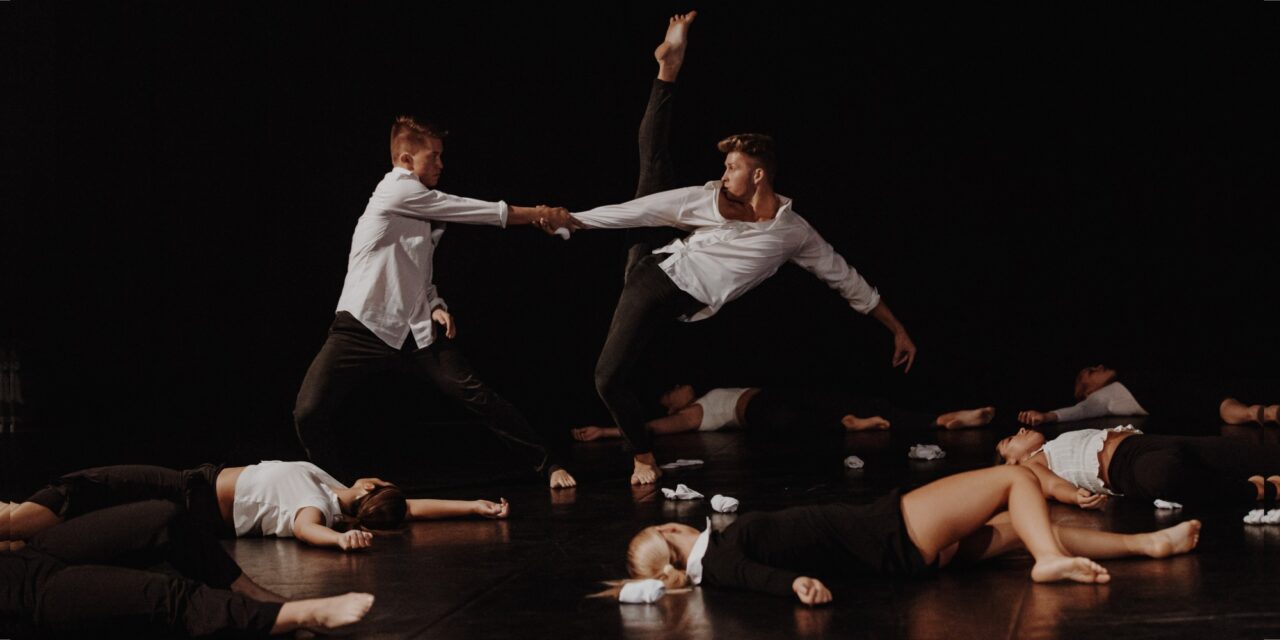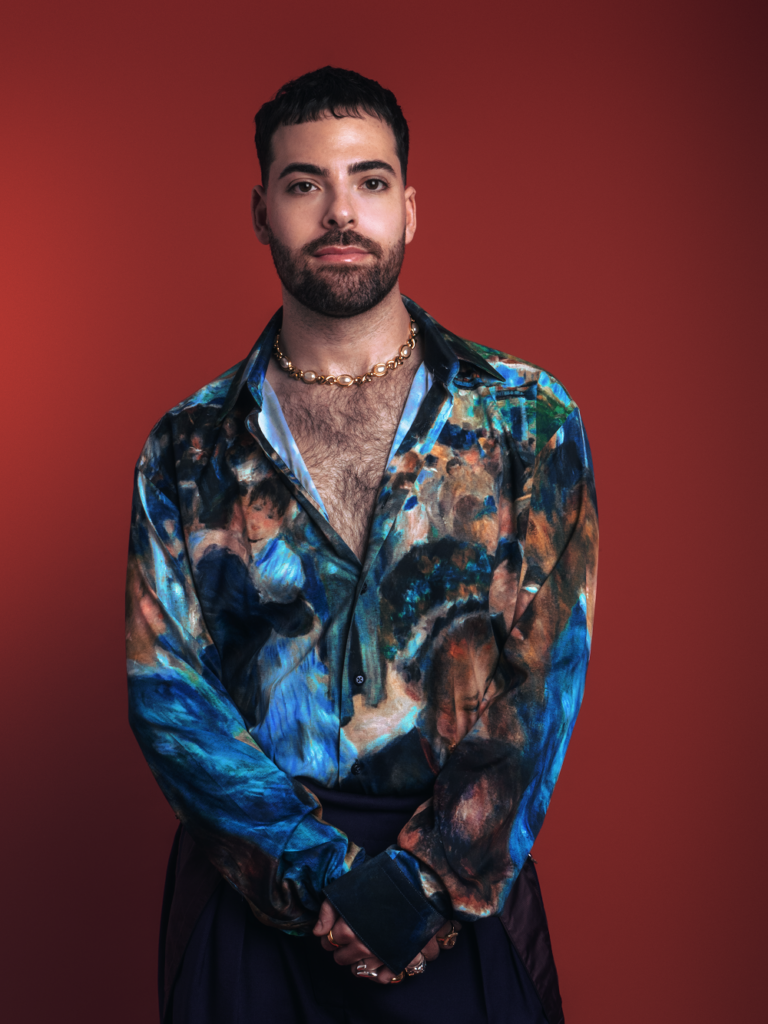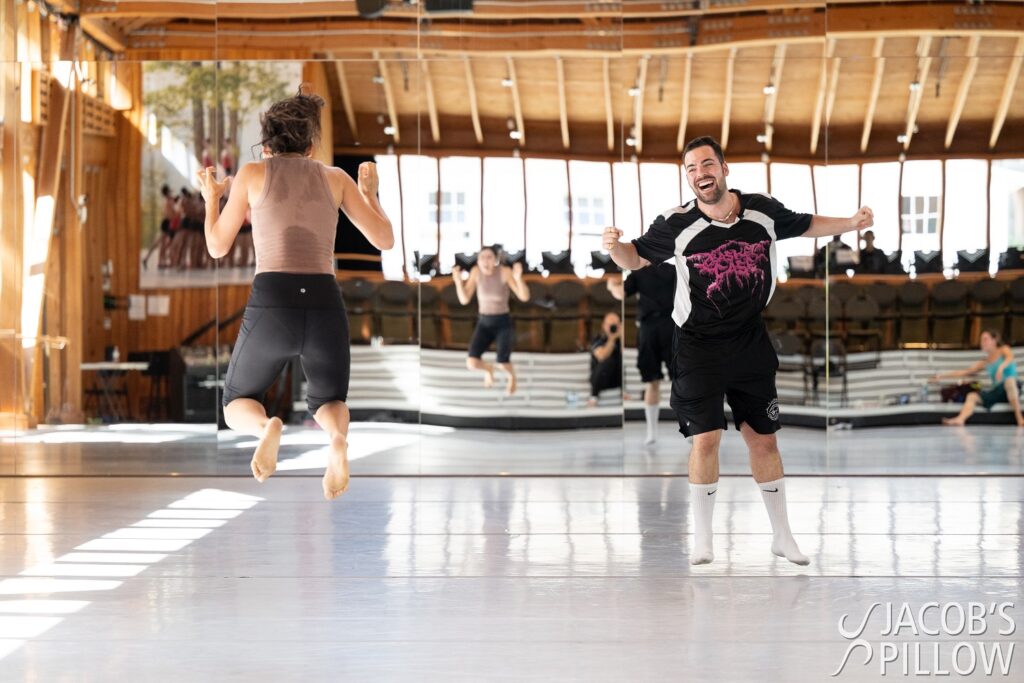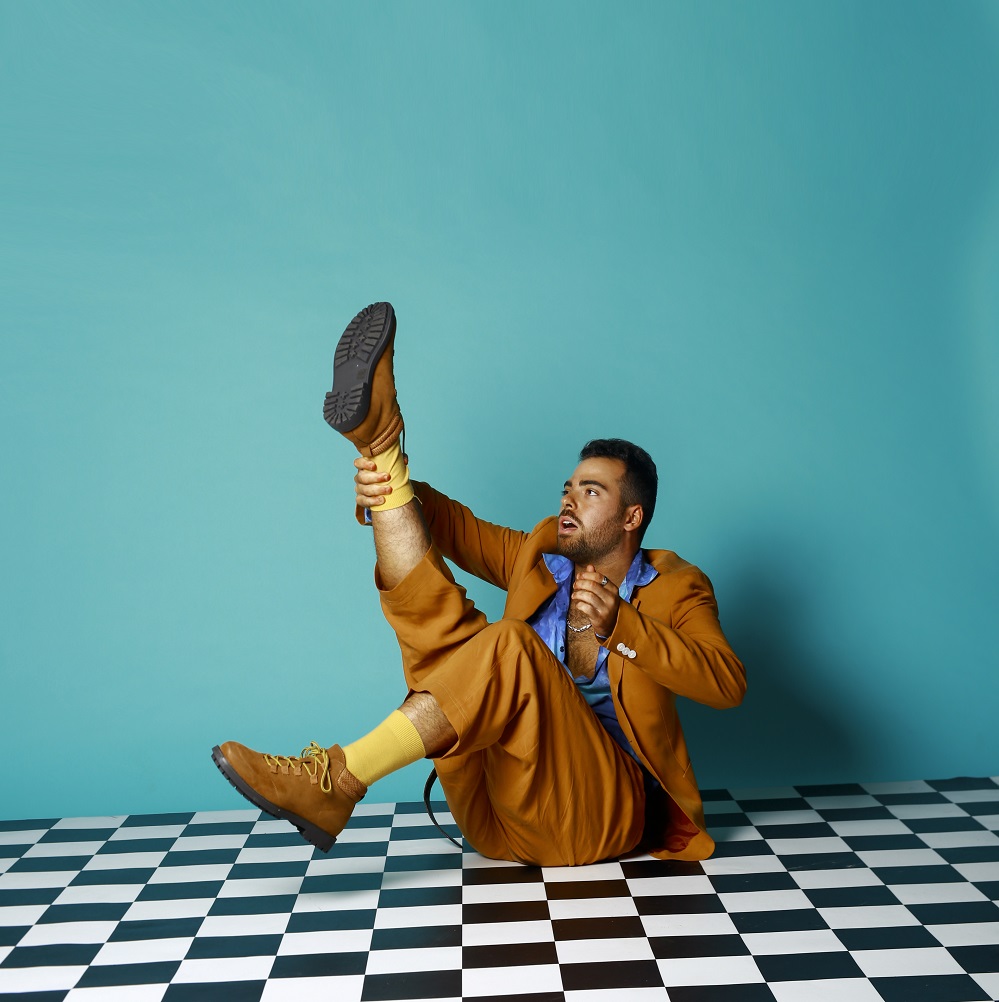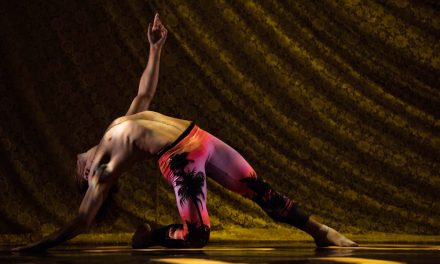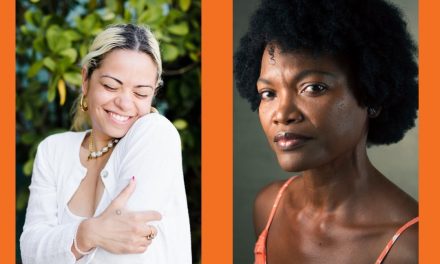At Highways Performance Space on March 15 – 16, 2024 at 8:30 pm, DySpRaXiAc DaNcE will present Two Months Too Early featuring choreography by artistic director Brian Golden. The press release describes Two Months Too Early as a “dance performance that delves into the deeply personal journey of choreographer Brian Golden and his disabilities- Dyspraxia and Auditory Processing Disorder. With insights from Brian’s neurologist and audiologist, this work beautifully captures the complexities between art and science.” Tickets are on sale now at https://www.highwaysperformance.org/shows
Although Brian Golden’s choreography has been awarded second place at the IAF (Iamforce) Choreographers Exhibit; third place at New Century Dance Project in Salt Lake City, Utah; and the Grand Prize for “CO:VID” a collaborative video experiment competition produced by Mike Esperanza, Brian Golden is not a familiar name among many in the Los Angeles dance community. To help correct this, Golden agreed to a Zoom interview to answer questions regarding his dance background; the title of his company, DySpRaXiAc DaNcE; his work Two Months Too Early; and more.
Golden grew up in Orange County and Los Angeles, attended Huntington High School Academy for the Performing Arts and received his BFA at Chapman University’s Department of Dance. He has presented work at the Joyce Theater as a part of the Martha Graham Company’s Fall season, Battery Dance Festival, Gibney Dance Center, Palm Springs Choreography Festival, and Southern California Institute of Architecture . Golden also completed a residency with the Batsheva Dance Company in Israel and has been mentored by Nina McNeely, Spenser Theberge, and Risa Steinberg.
Following graduation from Chapman, Golden has been traveling back and forth between Los Angeles and New York. “It’s been interesting to notice the different dance scenes – both amazing,” he said. “I love them both.
It was not until Golden was at Chapman University that he found out the reason for some of the learning struggles that he had been experiencing his entire life. Like the title of his company’s evening work Two Months Too Early, Golden was born two months prematurely and was placed in an incubator for two months so that he could breathe. “After that I was healthy, but my parents noticed I developed much slower than my peers,” he explained. He was slow to crawl, walk, ride a bike and other things that involved fine and gross motor skills. Working together with his right and his left are all part of what Golden calls coordination and effort
After being tested, Golden was diagnosed with Dyspraxia, also known as developmental coordination disorder (DCD), a common disorder that affects movement and coordination but not a person’s intelligence. He was also told that he has an auditory processing disorder which is actually centered on the left side of his brain. Golden explained that the left side of his brain is weaker than the right side which makes processing language and transferring information between the left and right side of the brain difficult. This makes multi-step directions such as learning choreography and deciphering words in a loud environment strenuous.
“For example, riding a bike, I would use too much effort and fall over. It was difficult for me to know how much muscle to use on tasks and maintain a steady effort once I found the correct effort. I think of petite allegro as a groove because you have to do the same amount of effort on the right as you do on the left.” Golden explained that he loved augmenting choreography and improvisation but does not enjoy doing other people’s choreography or even his own. “I like to create it and explore it, not to be trapped within the confines of doing A B C at the correct timing to music,” he said.
So, what led Golden to begin studying dance? He grew up as a competitive fencer and his sister is a talented singer who was performing in shows. Because he had always enjoyed more Avant Garde things, Golden began working in shows alongside his sister. He said that he did not know if he was good or not, but that dancing always felt great. “I didn’t know it back then but I was regulating my body and mind to work together,” he said. This led him to the Huntington High School Academy for the Performing Arts in Orange County where he discovered that he wanted to be a choreographer. Following graduation from the academy, Golden went on to Chapman University where he was inspired by teachers such as Julian O’Brien, Liz Maxwell and Jennifer Backhaus of Backhausdance. It was these professors who allowed Golden to trust his instincts and work in a way that was most beneficial to him.
During his sophomore and junior years at Chapman, Golden began entering his work at choreography festivals and winning awards. “I kind of hit the ground running and skipped the dancing part that most choreographers partake in.” He said while smiling. Golden does not think of himself as a perfectionist and rather values trusting instincts and exaggerated choice making. “That’s why I would describe my work as raw, intentional and always alive.
He describes himself as a sensory seeker, someone who wants energy and contrast. With Two Months Too Early, Golden said that he is trying to let himself out. “I’ve had a lot of really amazing mentors and a lot of them have told me to explore one idea because I have so many. I enjoy creating spaces where my collaborators feel empowered to explore a variety of personas and characters,” he said.
After explaining a work that he choreographed at Jacob’s Pillow that involved a man named Mr. Jackson and a dog where he shifted their personalities around, Golden said that he enjoyed creating characters that are “loud, exciting and shocking.”
Because he has to really analyze movement coordination, Golden thinks of his disorders as superpowers. “Am I using just my right hand? Do I want to use the whole body? Do I want to speed up the effort and then slow it down,” he questioned. “So, I’m very in tune with coordination and effort and how that also affects performative elements in the face.
While at Chapman, Golden studied film production as well as choreography. He is very driven by a character’s wants and needs and is always asking his dancers what is their intention or asking them what is their motivation. He feels that if two people want two different things that creates conflict and that good art has to have conflict.
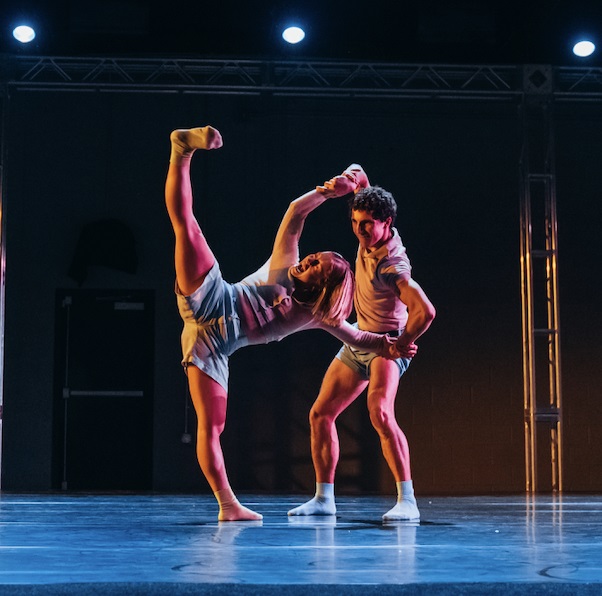
Maddie Lecambra, Josh Escover in Brian Golden’s “This is 22!” at Stomping Ground LA – Photo by Delaney Finnegan.
Because of his disabilities, Golden finds it interesting that he loves layering tasks. “Your legs are like octopuses while your hands are on fire and your face is intensely staring,” he described. So I really love these complex tasks, but it doesn’t have to be perfect. It’s an exploration of an outcome.”
Another challenge is counting music as he dances or choreographs. Golden prefers riding the wave of music as opposed to counting it. “I like thinking of music as a film score,” he said. “Now I see my musicality as a strength as well because I’m finding pockets or niche ideas that other people wouldn’t hear or maybe I only hear in my brain.” He meets his dancer halfway so that they “ride the wave of musicality together.”
It was while he was studying at Batsheva in Israel that Golden was able to dive into the Gaga technique and the improvisational imagery which has become a large part of his work. It has allowed Golden to feel alive in his skin and to become comfortable dancing and choreographing. “I have many different pools that I pull from but a lot of it is about task-based and intention-based work. Those are things that we explore in the studio,” he added.
Following the pandemic, a work that Golden created was chosen to be shown at the Battery Dance Festival in New York. Later on he received a call from Future Dance Festival run by Taryn Russell of 92NY. Russell was curating works to open for the Martha Graham Dance Company at the Joyce Theatre and his dance was one of those chosen. “That was a really, really amazing experience getting to go to the Joyce and show my piece “This ’22!” while I was 22 years old which I made in the peak of COVID,” he said. It was this experience at the Joyce and the sense of community that he felt with the dancers and choreographers he met that ultimately caused Golden to fall in love with New York.
In his works at Highways, Golden deals with the shame or feeling less than that he felt growing up because he had difficulties with simple things like riding a bike or tying his shoelaces. He investigates conformity, validation and denial. “I ask a lot of my dancers. We also use the voice and a lot of spoken word, with coordination – using the body and the voice at the same time, or just the voice or just the body,” he said.
“Sometimes it is like spilling your diary. I asked them to talk about secrets and have the body respond. Or I say, could you speak in gibberish or I might say tell me about the worst day of your life and we see what moves and words come up through that.”
Golden finds that his best work comes from working with characters like in his piece about Barbie Dolls. “It’s hard for me to pick music and solidify ideas if I don’t have this container or know where we are,” he added. “There doesn’t need to be a time period, although sometimes there is, but what is the movement language, what are our faces and what are we doing?”
One of Golden’s mentors that really inspired and encouraged him was Doug Varone. “He’s not a mentor who tries to make you like him. He wants to foster and end up with individual voices,” he said. The two still stay in touch.
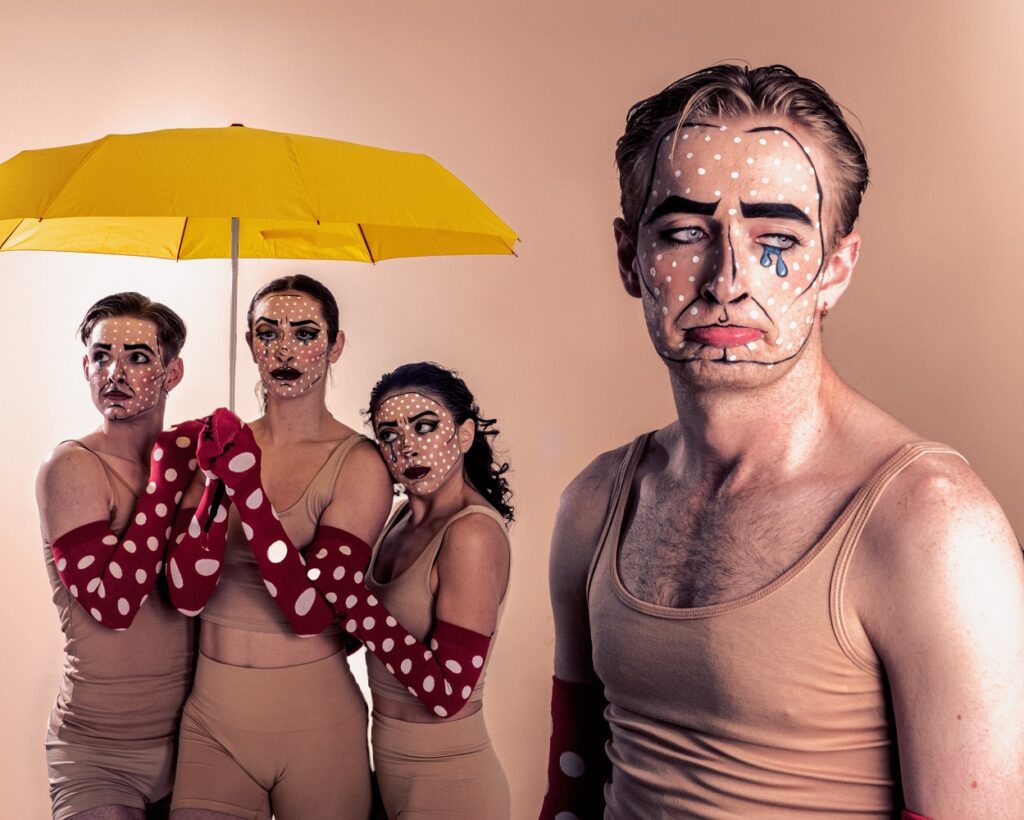
Jane Zogbi, Bella Allen, Donny Collinson, Spencer Seebach, Maddie Lacambra, and Dalya Modlin in Golden’s “Two Months Too Early” – Photo by Slade Segerson.
Golden does not write or chart out his dances on paper and he likes to get to know his dancers before beginning to create a work. He does, however, arrive at rehearsals with ideas and images to work with as a starting point. “I really think that the work is a product of myself and my collaborators at this moment, at this time,” he said. He then described the making of a work that began to feel too sad so he changed the music, added movements, and altered how the dancers reacted to the music. “It turned into a deranged clone-like wedding celebration,” he added.
The program at Highways includes two of Golden’s works. The shorter one (10 mins.) is titled More Is Less that premiered on the Disability Showcase at Stomping Ground L.A. The piece came about as a result of always hearing that less is more which was always difficult for him as someone who always wanted more ideas and more stimulation. While making More Is Less, Golden utilized charts that were given to him while working with his doctors, neurologists and occupational therapists.
His second and larger work, Two Months Too Early was inspired by the Pop Art movement and how he experiences the world. “So, it’s not a biography narrative about my disabilities,” Golden explained. “It’s more about me letting myself out. I want the audience to experience that sense of contrast and stimulation that I strive for.”
One of the things that Golden eventually hopes to accomplish is to create a warm-up class for neuro-divergent people that includes elements of improvisation but also elements of repetition.
The name of his disability is Dyspraxia while the title of his company is DySpRaXiAc DaNcE. Dyspraxiac is not a real word but to Golden it is trusting his instincts and is why he involves his collaborators and dancers. “It (DySpRaXiAc DaNcE) is not just me, everyone has a complex story and nuances that build up over time that makes every human unique. My intention is to employ surrealism and abstract ideas to create metaphors and symbols that merge to tell a story. The work holds a mirror up to every human, so they may feel seen, acknowledged, worthy and understood… and ultimately less alone.
WHAT: DySpRaXiAc DaNcE presents Two Months Too Soon.
WHEN: March 15 – 16, 2024 at 8:30 pm.
WHERE: Highways Performance Space, 1651 18th St, Santa Monica, CA 90404.
TICKETS: $25, tickets can be purchased at https://www.highwaysperformance.org/shows
To learn more about Highways Performance Space, please visit their website.
To learn more about Brian Golden, please visit his website.
Written by Jeff Slayton for LA Dance Chronicle.
Featured image: Ridge McGinley, Jacob Wiederrich and others in Golden’s Generally Happy at IAF Compound – Photo by Lexi Colvin.

